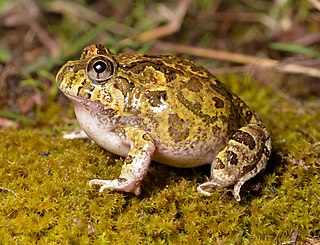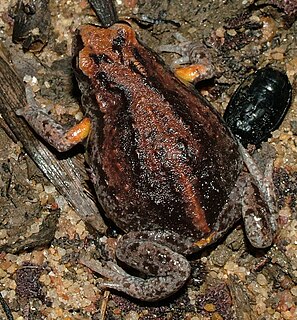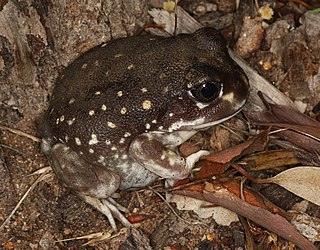
The giant burrowing frog or eastern owl frog is a large frog species that occurs in coastal south east New South Wales and Victoria in Australia.

The magnificent tree frog, also known as the splendid tree frog, is a tree frog species first described in 1977. It has a limited range, only occurring on the north-western coast of Australia in the Northern Territory and Western Australia. It has a similar appearance to, and can be confused with, the closely related White's tree frog.

The common eastern froglet is a very common, Australian ground-dwelling frog, of the family Myobatrachidae.

Heleioporus is a genus of frogs native to Australia. Of the six species in this genus, five live in south-west Western Australia, while the other one species only occurs in south-eastern Australia. All members of this genus are medium to large sized burrowing frogs with rounded heads, short bodies, bulging eyes, short limbs and the hands are free from webbing. The toes are relatively short with only a trace of fleshy webbing. A characteristic of this genus is the black nuptial spines that male frogs have on their first and occasionally second and third fingers. The pupil restrict to form a vertical slit and the tympanum is usually distinct. All the species in this genus call from burrows where the eggs are later deposited in a foam mass. Embryos develop in this mass until hatching. Hatching occurs after the burrows are flooded with water, and may be delayed until this happens. The calls of these species are similar although differ in frequency, length, note and repetition rate.

The tusked frog is a species of ground-dwelling frog native to eastern Australia from Eungella National Park, Queensland south to Ourimbah, New South Wales. It is the only species in the genus Adelotus - adelotus meaning "unseen" and brevis meaning "short".

The ornate burrowing frog is a species of ground frog native to Australia. It was moved to the genus Opisthodon in 2006, following a major revision of amphibians, and is now classified in the genus Platyplectrum

The northern sandhill frog is a small, fossorial frog native to a small region of the Western Australian coast. It was formerly considered the sole species within the genus Arenophryne until the first decade of the 2000s, when a new species of frog called the southern sandhill frog was discovered about 100 kilometres from Geraldton, Western Australia in Kalbarri National Park and given the scientific name Arenophryne xiphorhyncha.

The crucifix toad, or holy cross frog, is a species of frog in the family Limnodynastidae. It is a fossorial frog. It is one of the few Australian frogs to display aposematism. It is native to western New South Wales and south-western Queensland.

The painted burrowing frog is a species of burrowing frog native to western Victoria, eastern South Australia and southern New South Wales. They are also one of six species of frog which inhabit Kangaroo Island.

The Sudell's frog, painted burrowing frog, trilling frog or desert trilling frog is a species of burrowing frog common to a large part of southeastern Australia. It is found on and west of the Great Dividing Range of New South Wales to western Victoria and southern Queensland as well as far eastern South Australia.

The northern barred frog is a large, ground dwelling frog native to tropical northern Queensland, Australia.

The salmon-striped frog is a species of ground dwelling frog native to southeastern Queensland and northern New South Wales, Australia.

The large toadlet or great toadlet or major toadlet is a species of ground-dwelling frog native to eastern Queensland (including Moreton and North Stradbroke Island and northern New South Wales, Australia.

The rough frog, also known as the warty water-holding frog, is a burrowing frog native to New South Wales and Queensland, Australia.

The marbled frog or marbled marsh frog is a species of ground-dwelling frog native to northern and north-eastern Australia, and southern New Guinea in both Indonesia and Papua New Guinea.

Spencer's burrowing frog is a species of frog native to western and central Australia.

The western spotted frog is a species of frog in the family Limnodynastidae. It is endemic to Western Australia. Its natural habitats are temperate forests, temperate shrubland, intermittent rivers, freshwater marshes, rocky areas, granite outcrops, arable land, pastureland, open excavations, and canals and ditches. It is threatened by habitat loss and salinity.
The hooting frog is a species of frog in the family Limnodynastidae. It is endemic to Australia. Its natural habitats are temperate forests and intermittent rivers.
The humming frog is a species of frog in the family Limnodynastidae. It is endemic to Australia. Its natural habitats are temperate forests, temperate shrubland, Mediterranean-type shrubby vegetation, intermittent freshwater marshes, rocky areas, arable land, pastureland and open excavations.


















